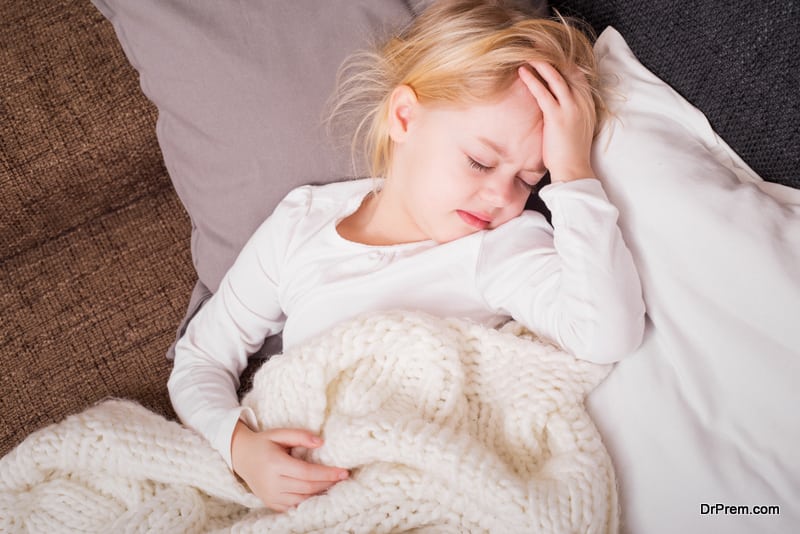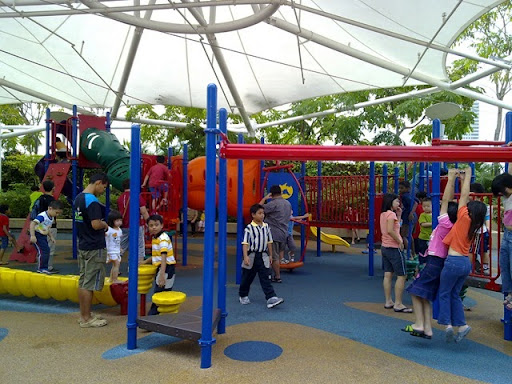Although, headaches in children have never been uncommon; sometimes they can be associated with complicated neurological conditions like a Migraine. Just like their adult counterparts, children may complain about headaches usually due to stress, tension, infection or minor head injury. However, if the issue is persistent and accompanied with other symptoms like nausea, vomiting, dizziness, etc. then it is advisable to seek immediate medical attention; as it could be a migraine!
A migraine: An overview
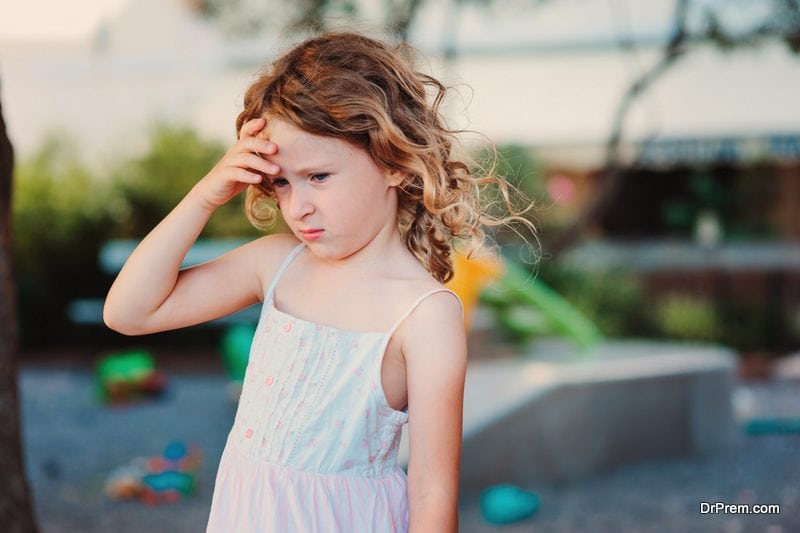
Unfortunately, migraine has been reported as one of the most common issues with school-age children, leading to their decreased quality of life. Studies have reported that a childhood migraine is more common in boys than in girls, affecting almost 1.8-2% of teens and 0.6% of children. Surprisingly, incidences of a migraine in 4 years old and even 18 months old kids have reported.
It should be noted that migraine symptoms and treatments in kids, as well as teens, can be different from adults. In children, migraine attack can usually occur for one to four times a month that may typically last for 30 minutes to almost for 6 hours. During the episode, your child may complain about a throbbing pain in either one or both the sides of the head, often with nausea, vomiting, dizziness, and abdominal pain. Children tend to become more sensitive to light, touch, and noise. These migraine symptoms are often subsided after a sleep; and hence, children are advised to lie down to make them feel better.
Phases of Migraine Attacks
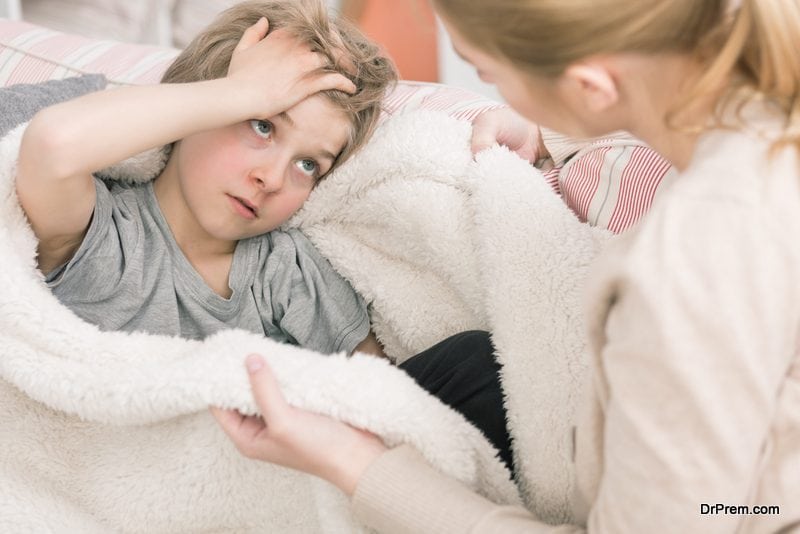
Studies indicated four possible phases of migraine attacks, which can be noted as:
- Prodrome or premonitory phase:- The phase typically is noted 24 hours prior to a headache in children, during which they express certain manifestations like irritability, mood swings, fluctuations in their appetite, water retention, disturbed sleep pattern, etc. These early signs are evident in a migraine with or without aura.
- Aura:- An aura is a specific symptom, initiating right before a migraine headache and is associated with lack of visual ability, lack of coordination, sensory disturbances, numbness, tingling sensation in the face and fingers, and in rare cases slurry speech. Other than these specifically mentioned symptoms, some auras can be noted with a loss of concentration, confusion, irritability, agitation, vertigo, and
- Headache: – The actual phase of a headache in children is shorter in time, with symptoms as specified later.
- Postdrome:- The phase is more commonly associated with a feeling of exhaustion and lethargy. The child may feel tired, disturbed and sleepy.
Kids who have reported 15 or more headache days in a month with episodes lasting for more than 5 hours to 3 months can be suffering from a chronic migraine and should be paid special attention. Chronic childhood migraine can be severely disabling. It can have a negative impact on their academic performances and disturb physical as well as mental well being of the child.
Thus, it is important to note some of the unique symptoms of a migraine in order to differentiate it with common headaches in children, in order to incorporate a safe and effective option for prevention.
Migraine symptoms
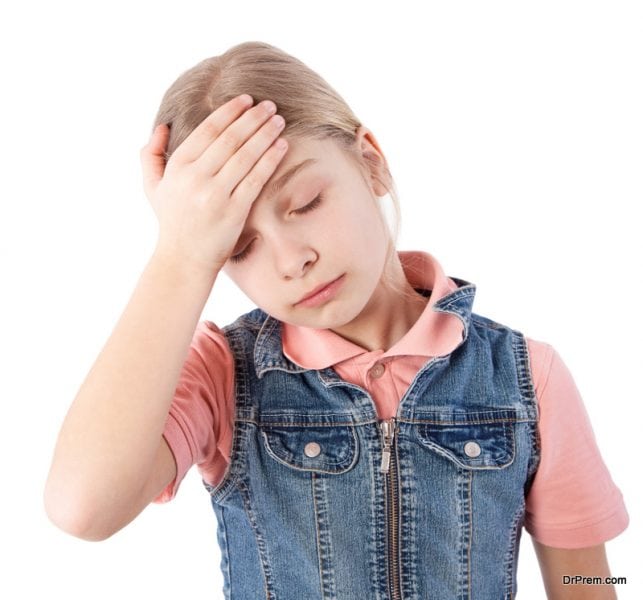
Children with migraines typically express one of the four symptoms.
- Motion sickness:- Along with abdominal pain, many children may suffer from severe motion sickness that is to be considered as both the indicator as well as the predictor of a migraine Reportedly headaches in children suffering from a migraine get aggravated while driving, on a merry-go-round or during field trips.
- Banging on the head: – Children who are too young to speak are observed to be banging their heads in order to get rid of the extreme pain. It can be considered as one of the severe manifestations of headaches in children. Experts are still trying to figure out the exact cause of headbanging, but have related it with extreme abdominal pain, headaches, light sensitivity or their inability to speak. As a parent, it is important to note your toddler’s body language, as to whether he has become extremely irritable without any reason, is crying incessantly or is rocking his body or banging his head to soothe If any of the signs are being noted, it could be a migraine.
- Fatigue: – If you observe your child to be tired along with other symptoms noted then you get your child treated for a migraine.
Thus, if any of the above symptoms are noted in your child along with other common migraine symptoms such as abdominal pain, irritability, dizziness, vomiting etc. it is advisable to get immediate medical attention.
What are the migraine triggers?

It has been identified that multiple factors act as a migraine trigger and can be noted as:
- You child can complain about a headache after eating certain food like cheese or milk products, citrus food, chocolates, fizzy drinks, etc.
- Experts have advised not to skip a meal, in order to avoid headaches in children; since depletion in blood sugar level can act as a trigger to migraine episode.
- Disturbed sleep or sometimes even oversleeping can stimulate a headache. Hence it is always better to maintain regular sleeping patterns.
- Children should be asked to avoid stress, anxiety that can serve as the leading trigger to their migraine attack.
- If your child is suffering from a chronic migraine, it is always better to avoid excessive physical exercise. Instead of which yoga practices that can bring in mental as well as physical harmony can be implemented.
- In many instances, it has been observed that children exposed to flickering lights or fluorescent tube light may complain about headaches and hence can be avoided.
Migraine Treatment
Although a migraine can be treated completely with the medication and self-care at home, it is important for parents to know when to worry!
Migraine self-care

Experts have suggested that sleep is the most powerful migraine remedy. It helps in restoring normal brain function to minimize pain. Studies have indicated that sleep can resolve many associated symptoms of migraines including irritability, anxiety, stress, etc. Maintenance of regular lifestyle schedules such as enough sleep, regular meal, and stress-free living can be helpful in controlling headaches in children. Recognizing your child’s migraine triggers can be helpful in reducing the frequency of episodes. In this regard, doctors advise maintaining a record which should include all the details, such as
- Date and time of the migraine episodes
- Forms and location of a headache
- Any notification of auras
- Details mentioning food and drinks consumed
- Time of sleep, play, exercise pattern, followed.
- Self care habits incorporated for better results
If headaches in children are not reasonably controlled within 3 to 6 months post-treatment, it is always advisable to seek pediatric neurologist to rule out the possibility of any other neurological indication.


